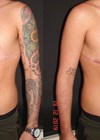
Dr Vincent Wong explains why skin health is particularly important when it comes to treating drag queens and how to help them glow.
In an era of gender fluidity, facial masculinisation and feminisation treatments are rising in popularity. As we celebrate diversity and inclusivity in medical aesthetics, it is important to understand the unique needs and aesthetic goals of patients from the LGBTQ+ community.
More patients from the community are coming forward to have treatments that can help them reduce the feeling of body dysphoria, whilst others seek treatments to match their outer appearance to their true inner identity [1]. This trend is also influenced by popular mainstream TV shows such as RuPaul’s Drag Race and the increasing acceptance of the LGBTQ+ community. We can achieve a lot of structural changes to the face with injectable treatments using modalities such as neurotoxins, dermal fillers, and suspension threads [1]. However, skin health remains an overlooked area. Healthy skin is a reflection of our overall well-being regardless of age, gender, sexuality or race. As aesthetic practitioners helping members of the LGBTQ+ community achieve the change that they want, we must also look beyond facial structures and shapes, to focus on skin health as part of our treatment plan.

This article will focus on drag artists, as they represent a unique niche area when it comes to skin health. Drag queens embody a wide range of possibilities for the combinations of facial appearances and aesthetic goals that are characteristically male and / or female. One of the key components of a drag persona is the creative use of makeup to achieve a feminine visage on genetically male skin – that, in itself, poses challenges when it comes to skin health. In order to fully appreciate this, we must firstly understand the unique characteristics of male skin and the impact of the prolonged use of makeup products.
Male skin and makeup
A good knowledge of the physiological, chemical, and biophysical characteristics of male skin is imperative for the proper management of skin quality. A number of studies comparing male and female skin have found that sebum content and transepidermal water loss are higher in men [2,3,6-8]. In addition, men are more prone to skin pigmentation, inflammatory conditions of the skin (such as acne) and deep wrinkling of facial skin despite having thicker skin [4-8]. These findings are thought to be partially influenced by sex hormones [5,8]. Visible skin conditions such as acne can have strong emotional implications and have been linked to depression, anxiety and lower self-esteem [9]. Many drag performers suffer from such skin conditions and use heavy makeup as camouflage when they are in drag. This forms a vicious cycle – apart from clogging pores in the skin, there is a greater chance of makeup products causing a breakout if thick makeup is used regularly for prolonged periods of time.

A key step to healthy skin is protection against harmful UV rays. Whilst most cosmetic makeup products usually come with a degree of UV protection, this is often too low and leaves users under the false sense of security that the skin is protected. Leaving makeup on for long periods under direct sunlight or UVA exposure (e.g. lighting, computer and mobile phone screens) can lead to premature development of ageing signs such as age spots and wrinkles, not to mention the risk of skin cancer. Harsh chemicals, such as polyethylene glycols and phthalates, can also often be found in many makeup products. These ingredients can disrupt functions of the protective barrier of the skin, making it easier for environmental pollutants to penetrate the skin and break down collagen and elastin through a series of inflammation processes. When treating drag queens, it is important to take into account the fact that most of them have to regularly perform vigorous dance routines under very bright lighting. The UVA exposure and excessive sweating can make them more susceptible to the skin damages discussed above.
Topical treatments and patient feedback
Thankfully, there are effective medical treatments such as skin peels and medical-grade skincare products that can help restore skin health, and potentially reduce the dependence on makeup products amongst drag queens. In my clinic, I use the Definisse™ Peel Program as the first-line topical treatment when it comes to helping drag queens improve their skin health. The peel system comes with a choice of pre-peel and peel solutions, allowing me to provide a tailored treatment. The peel solution is a unique combination of salicylic, pyruvic and retinoic acids that work on the deep layers of the skin without excessive peeling. This is then followed by a medical-grade skincare regime using products from AlumierMD. My go-to products are the EverActive C&E™ serum, retinol, and physical sunscreens. Below are some examples of feedback that I have received.
A’Whora (RuPaul’s Drag Race UK Season 2):
“Since visiting Vincent, my confidence has changed completely. I feel a lot better when I apply my makeup – I feel like I am needing less makeup and that I am doing less work with it.”
Bimini Bon Boulash (RuPaul’s Drag Race UK Season 2):
“My skin has been glowing! I’m obsessed with the AlumierMD sunscreen – it leaves such a nice glow on my skin afterwards, and it’s really moisturising, keeping my skin looking fresh. It is a 10 out of 10 for me.”
References
1. De Boulle K, Furuyama N, Heydenrych I, et al. Considerations for the use of minimally invasive aesthetic procedures for facial remodeling in transgender individuals. Clin Cosmet Investig Dermatol 2021;14:513-25.
2. Firooz A, Sadr B, Babakoohi S, et al. Variation of biophysical parameters of the skin with age, gender, and body region. Sci World J 2012;2012:386936.
3. Man MQ, Xin SJ, Song SP, et al. Variation of skin surface pH, sebum content and stratum corneum hydration with age and gender in a large Chinese population. Skin Pharmacol Physiol 2009;22:190-9.
4. Chen W, Mempel M, Traidl-Hofmann C, et al. Gender aspects in skin diseases. J Eur Acad Dermatol Venereol 2010;24:1378-85.
5. Eisenbeiss C, Welzel J, Schmeller W. The influence of female sex hormones on skin thickness: Evaluation using 20 MHz sonography. Br J Dermatol 1998;139:462–7.
6. Firooz A, Rajabi-Estarabadi A, Zartab H, et al. The influence of gender and age on the thickness and echo-density of skin. Skin Res Technol 2017;23:13-20.
7. Ishikawa T, Ishikawa O, Miyachi Y. Measurement of skin elastic properties with a new suction device (I): Relationship to age, sex and the degree of obesity in normal individuals. J Dermatol 1995;22:713-17.
8. Jacobi U, Gautier J, Sterry W, Lademann J. Gender-related differences in the physiology of the stratum corneum. Dermatology 2005;211:312–17.
9. Levy L, Emer J. Emotional benefit of cosmetic camouflage in the treatment of facial skin conditions: personal experience and review. Clin Cosmet Investig Dermatol 2012;5:173-82.
Declaration of competing interests: The author has been reimbursed by ReLife, the manufacturer of Definisse dermal fillers, for attending several conferences and for conducting clinical studies.
COMMENTS ARE WELCOME









